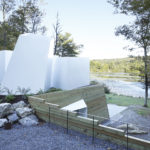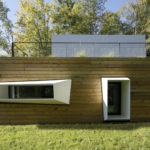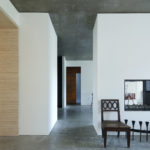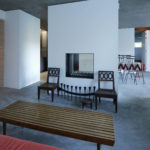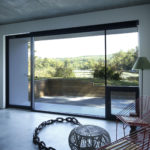Lake House | Taylor and Miller Architecture and Design
Project's Summary
The Lake House, crafted by Taylor and Miller Architecture and Design, is a remarkable residence nestled in the picturesque landscapes of Western Massachusetts. This architectural gem showcases a dualistic relationship with the serene lake it overlooks. From the street, the house presents an abstract facade, devoid of windows or openings, creating a sense of mystery and intrigue. However, as visitors journey along the walking path towards the lake, the true essence of the home is revealed. A striking stacked timber wall not only serves as a retaining structure for the surrounding landscape but also acts as the primary enclosure for the residence, punctuated by carefully designed openings that draw the eye towards the lake.

Upon entering the Lake House, guests are greeted by a fascinating interplay of spatial orientations. The design introduces two distinct experiences: a horizontal orientation defined by the sleeves that offer picturesque views of the lake and a vertical orientation that invites the gaze upward, connecting the interior spaces with the expansive sky. Each orientation is thoughtfully articulated through varied materiality. The horizontally-oriented spaces exude a sense of calm with their neutral tones, creating a harmonious environment that encourages relaxation and reflection. In contrast, the vertically-oriented spaces feature dynamic elements, such as a skylight that floods the areas with natural light and dramatic shifts in materials, highlighting the unique character of each space.

The entry vestibule welcomes visitors with its stacked plywood, setting the tone for the journey within. As one progresses into the kitchen, the hot-rolled steel surfaces evoke a sense of modernity and sophistication, while the rusted steel stairway becomes a sculptural element that captivates the eye. These vertical spaces present a cinematic 'hard cut' that challenges traditional notions of continuous flowing space, offering a striking contrast to the more tranquil horizontal areas. This thoughtful design approach not only enhances the aesthetic appeal of the Lake House but also creates a dynamic experience for those who inhabit it.

As the day unfolds, the Lake House transforms with the shifting light, offering an ever-changing canvas of views and sensations. The carefully curated spatial relationships between the home and its surrounding landscape foster a deep connection with nature, inviting occupants to engage with their environment. Taylor and Miller Architecture and Design have masterfully crafted a residence that is not only visually stunning but also profoundly attuned to the rhythms of the lake and sky. This architectural masterpiece serves as a testament to the beauty of modern design, where form and function coexist in perfect harmony.

In conclusion, the Lake House stands as an exemplary model of contemporary architecture, seamlessly integrating with its breathtaking surroundings. It is a celebration of the natural world, offering a serene retreat for those who seek refuge in the embrace of nature. Taylor and Miller Architecture and Design have truly redefined the concept of lakeside living, creating a home that is not only a shelter but also a sanctuary that inspires and uplifts its inhabitants.
Read also about the Arbor by Kerimov Architects in Moscow project
